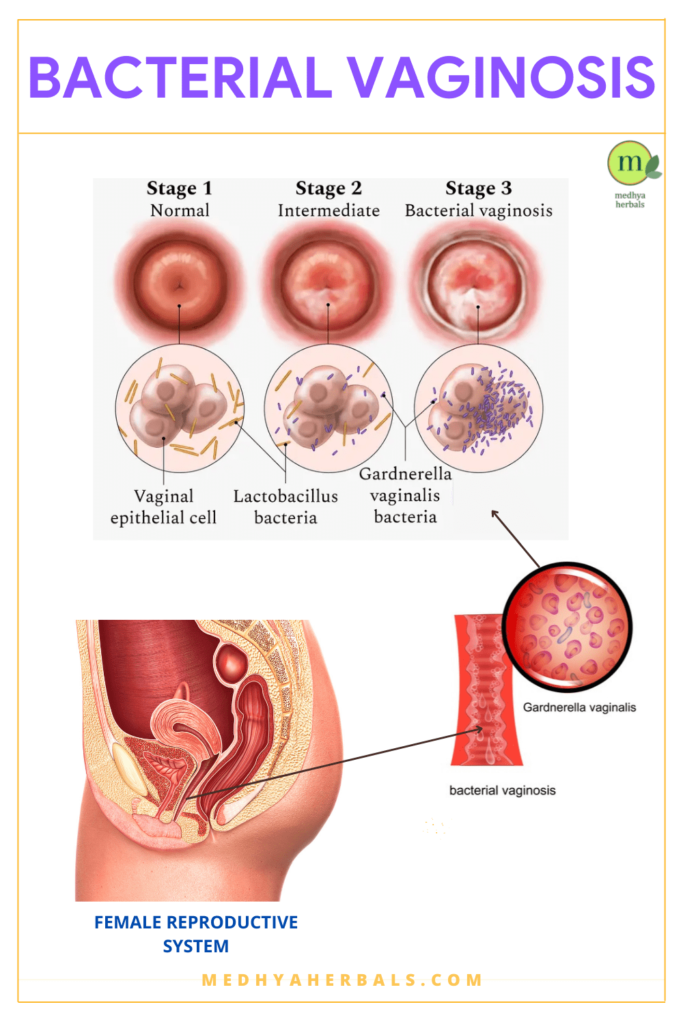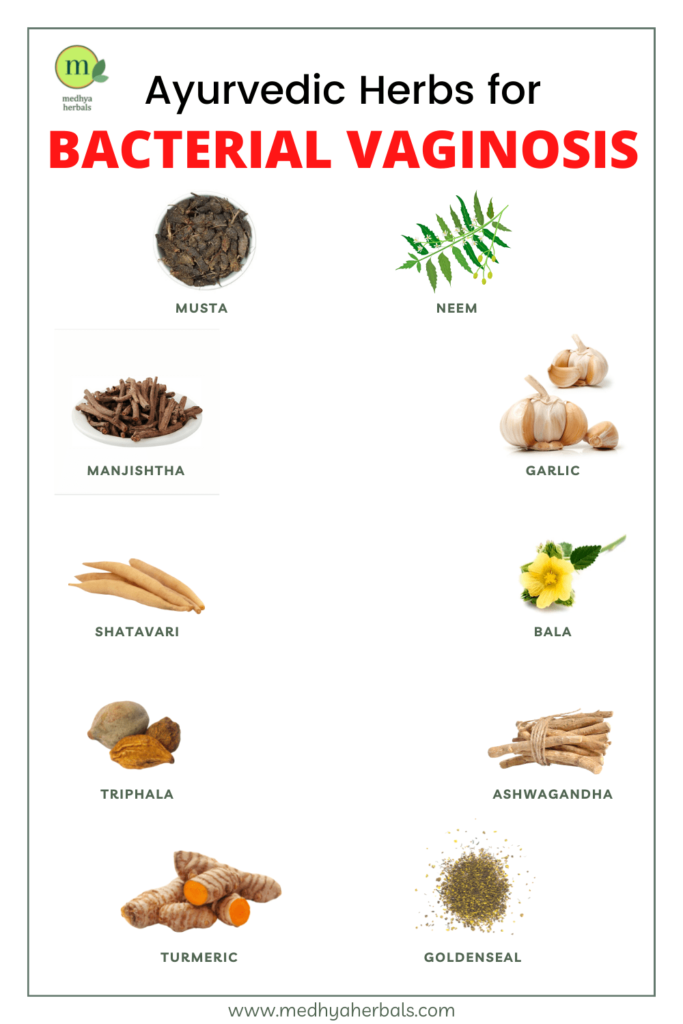Do you have a fishy smell coming from your vagina? If so, you may have Bacterial Vaginosis (BV), a common vaginal infection that affects millions of women every year. BV is caused by an overgrowth of bacteria in the vagina, and can lead to a variety of unpleasant symptoms, including vaginal odor, discharge, and itching.
Many women are embarrassed to talk about it, but it is important to get treated if you have bacterial vaginosis. Ayurveda is a holistic system of medicine that offers highly effective natural treatment options for BV.
In this article, we will discuss some of the best Ayurvedic remedies for Bacterial Vaginosis.
What is Bacterial Vaginosis?
Bacterial vaginosis (BV) is a condition that happens when there is an imbalance between good and bad bacteria in the vagina. The good bacteria help to keep the pH level balanced and prevent the growth of harmful bacteria.

When there is too much of certain kinds of bacteria in the vagina, it upsets the normal balance of vaginal flora and pH. This leads to white discharge, vaginal itching, burning sensation and foul smell out of the vagina.
Bacterial vaginosis is the most common vaginal infection among women of childbearing age. Vaginal infection due to bacteria is also known as vaginitis, vulvovaginitis and vaginal bacteriosis.

What you need to know about bacterial vaginosis
Bacterial vaginosis is different from vaginal candidiasis (a vaginal yeast infection due to candida albicans) and vaginal trichomonas (a sexually transmitted infection).
Vaginal bacteriosis is not a sexually transmitted infection (STI). However, BV can make you prone to STI and also lead to painful sexual intercourse.
Causes of Bacterial Vaginosis
The cause of BV is not fully understood. It is believed to be caused by an imbalance in the good and bad bacteria that are normally found in a woman’s vagina. Here are some of the primary factors that disturb the bacterial flora, leading up to infection in the vagina.
- Frequent/excess use of antibiotics
- Use of vaginal douches and vaginal sprays
- Antibacterial soaps
- Spermicides
- Changes in hormone levels during pregnancy, menopause, breastfeeding
- Hormonal imbalances due to Diabetes, PCOS, Endometriosis, Obesity
- Frequent intercourse with multiple sex partners
Symptoms of Bacterial Vaginosis
The main symptom of BV is white or grey milky discharge, foul smell and fishy odor from the vagina and vaginal pH greater than 4.5.
Other symptoms include:
- skin itching
- burning sensation
- vaginal skin irritation
- swelling, soreness and redness of vagina
- pain during or after intercourse
- foul smelling vagina after sexual intercourse
- abnormal vaginal discharge
If you have BV, you may notice that your vaginal discharge is thin and watery. It may be white, gray, or yellow in color.
You may also have BV if you experience any itching, burning sensation, or irritation around your vulva and vagina. If you have any of these symptoms, it’s important to see your doctor so they can diagnose and treat the infection.
Getting Right Treatment for Bacterial Vaginosis
It is important to get professional medical advice if you think you have bacterial vaginosis so that it can be treated. BV is a common infection, but it can lead to other serious health problems such as:
- Pelvic inflammatory diseases and urogenital infections if it’s not treated.
- If you are pregnant, BV can cause premature delivery and low birth weight babies.
- BV can also increase your risk of getting sexually transmitted diseases such as such as chlamydia and gonorrhea.
So, it’s important to get treated if you think you have BV.
Prevention of Bacterial Vaginitis
There are a few things you can do to help prevent BV:
- Avoid douching. Douching can upset the natural balance of vaginal bacteria and pH, leading to the growth of unhealthy bacteria.
- Use condoms during sexual intercourse. This will help to protect you from Sexually transmitted infections, which can increase your risk of BV.
- Maintain healthy vagina by keeping it clean and dry. Wash with normal water if required and change underwear frequently.
- Always prefer to wear cotton undergarments. Stay clear from synthetic fabrics, specifically for inner wear.
- Avoid tight clothing and prefer loose clothes to let air circulation happen
- Avoid using hot tubs and public swimming pools.
- Make sure to wipe from front to back as it will prevent spread of bacteria into the vaginal area.
Ayurvedic Treatment for Vaginitis Infection
The goal of Ayurvedic treatment is to restore the normal balance of bacteria in the vagina. Ayurvedic treatment for BV involves Ayurvedic medicines, herbal remedies, diet and lifestyle changes to detox and flush out bad bacteria, reduce inflammation and boost the immunity.
Health conditions related to vaginal infections, menstrual disorders and structural problems in the vagina fall under the category of yoni vyapat in Ayurveda.
Bacterial vaginosis is considered to be Sannipatik Yoni vyapat, meaning all three dosha – vata dosha, pitta disha and kapha dosha are affected.
- vata imbalance leads to abnormal discharge and painful intercourse
- pitta imbalance leads to foul smell, inflammation, burning sensation, skin rashes and skin allergies
- kapha imbalance leads to white colour vaginal discharge, mild pain and excess wetness due to heavy vaginal discharge
Herbs and Ayurvedic Medicines for Vaginitis Infection

Ayurvedic herbs have antimicrobial properties that help to clear away the bacteria that is causing the infection. They also help to soothe and calm the inflamed tissues in the vagina, which can help to speed up healing.
Ayurvedic medicine and herbs are highly effective in bacterial vaginosis treatment. To alleviate kapha and vata dosha, dry and hot in potency Ayurvedic medicines and herbs are used.
Some examples of Ayurvedic medicine for white discharge and pelvic pain include trikatu, triphala, palasha, neem, dadima, musta, manjishtha.
The digestive Ayurvedic herbs like cumin, fennel, fenugreek, cardamom, cumin, ginger, garlic increase agni, destroy the harmful bacteria and fungal infection.
Ayurvedic herb like turmeric, brahmi, ashwagandha, bala, saffron and shatavari support mental health and reproductive organs, promote hormone balance and boost immunity.
Some other common herbal remedy for BV include goldenseal, oregon grape, and berberine.
If you are experiencing symptoms of bacterial vaginosis, it is best to speak with a qualified Ayurvedic doctor or a herbalist who can recommend a specific blend of herbs tailored to your individual needs.
Herbal Remedies to treat BV at Home
- Turmeric and licorice powder, taken separately, can be used as a healing herbal combination. Drink two teaspoons of this mixture twice a day until your symptoms disappear.
- A vaginal douche with either Triphala powder or Punarnava powder is effective for thick white discharge that is accompanied by itching and a burning sensation. Boil 1 tablespoon of powder in a litre of water, cool it to half a litre, strain it, and use it as a douche.
- Heat 2 cloves of crushed garlic in 2-3 tbsp of coconut oil or mustard oil. Let the oil cool down. Apply this oil as a vaginal douche. Both garlic and coconut oil have antibacterial and antifungal properties.
- Vaginal douche made with 2-3 drops of tea tree oil in 1 tbsp of coconut oil is highly effective against bacterial infection.
Ayurvedic Diet and Lifestyle for treatment of BV
An important part of supporting your health, good gut and vaginal flora and boosting your immunity is through your diet and lifestyle.

Ayurveda provides specific guidelines that can help to reduce the symptoms of Bacterial Vaginosis and speed up healing.
- Avoiding sugary and processed foods, as well as caffeine and alcohol, can help to reduce inflammation and detox the body.
- Eating plenty of fresh fruits and vegetables, as well as whole grains, can help to boost the immune system and fight off infection.
- Make sure to drink plenty of water throughout the day to keep the body hydrated and flushed out.
- Exposing the body to sunlight for 15-20 minutes each day can help to increase vitamin D levels, which can also help to fight off infection.
- Practicing stress-reducing activities like yoga or meditation can help to reduce inflammation and promote healing.
- Herbal teas made with ginger, turmeric, or licorice can help to soothe the symptoms of Bacterial Vaginosis and speed up healing.
Takeaway!
Your vagina is an important part of your health. It affects your sex life, ovulation and pregnancy. Even though it is one of the vital organs, not a lot is talked about taking care of it.
Talking about vaginal problems is still a taboo and people feel embarrassed. We don’t have a lot of knowledge about how to take care of our vaginas, so we often don’t give them the care they need. Although vaginal problems are generally not that serious, ignorance and misconceptions can lead to complicated situations.
Consult with Medhya’s Ayurvedic Doctor to get your personalised health plan involving prescription for Ayurvedic medicine, diet, yoga and lifestyle guidelines.
FAQ
Can Ayurveda cure bacterial infection?
Yes, Ayurveda can definitely help to cure bacterial infection. In fact, it is one of the most powerful holistic systems of medicine in the world and has been used for centuries to treat a variety of health conditions.
Ayurveda is all about restoring balance in the body by identifying and treating the root cause of the problem. It does this by using a variety of methods including dietary changes, herbs, aromatherapy, and massage therapy.
So if you are suffering from a bacterial infection, I would highly recommend seeking out an Ayurvedic doctor for treatment. They will be able to assess your individual situation and prescribe a treatment plan that is specifically tailored to your needs.
How do you wash your vagina with Triphala?
Triphala is an Ayurvedic herbal formulation that is thought to be beneficial for cleansing the gut and promoting regularity. It is made up of equal parts of three different herbs – Amalaki (Emblica officinalis), Haritaki (Terminalia chebula) and Bibhitaki (Terminalia belerica). According to Ayurveda, these herbs work together in harmony to support digestive health and balance the doshas, or Ayurvedic body types.
To use Triphala for washing the vagina, simply mix a teaspoon of the powder with a cup of warm water and use it like you would any other herbal vaginal wash. Some women also like to add neem capsules or neem leaves to triphala mix.
References
Antibacterial activity of some Indian Ayurvedic preparations against enteric bacterial pathogens
Dhatakyadi Varti – An effective local treatment for Upapluta YonivyapadDhatakyadi Varti
Systematic review: The potency of Zataria multiflora Boiss in treatment of vaginal infections

